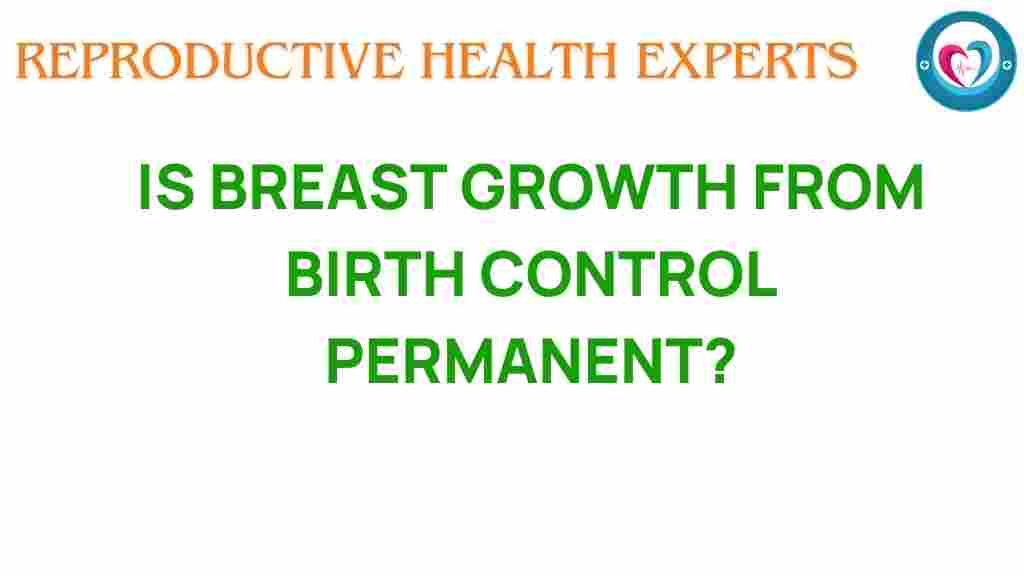Is Breast Growth from Birth Control a Permanent Change?
The journey of women’s health is often intertwined with the choices they make regarding contraception. One of the most discussed side effects of hormonal birth control is breast growth. Many women wonder if this change is permanent or temporary. In this article, we will explore the relationship between birth control and breast growth, the hormonal effects involved, and what women can expect regarding body changes.
Understanding Breast Growth and Birth Control
Breast growth as a result of birth control is primarily attributed to the hormonal components present in various contraceptive methods. Most hormonal contraceptives, such as pills, patches, and injections, contain estrogen and/or progestin. These hormones can influence breast tissue, leading to noticeable changes.
- Estrogen: This hormone plays a significant role in developing female characteristics, including breast tissue.
- Progestin: Often included in birth control, progestin can also affect breast size and fullness.
When women start using hormonal birth control, they may experience an increase in breast size due to the swelling of breast tissue. This change can occur within the first few months of starting the contraceptive method.
How Birth Control Causes Breast Growth
The mechanism behind breast growth from birth control involves several hormonal effects:
- Fluid Retention: Hormonal changes can lead to fluid retention in the breast tissue, temporarily increasing size.
- Increased Blood Flow: Hormonal contraceptives can enhance blood flow to the breasts, contributing to fullness.
- Breast Tissue Development: Estrogen in birth control can stimulate the growth of glandular tissue in the breasts.
Is the Growth Permanent?
One of the most important questions women ask is whether the breast growth caused by birth control is permanent. The answer is not straightforward; it largely depends on several factors, including:
- Duration of Use: Short-term use may lead to temporary changes, while long-term use could cause more significant alterations.
- Type of Contraceptive: Different contraceptives have varying levels of hormones, affecting the extent of breast growth.
- Individual Body Response: Every woman’s body reacts differently to hormones, making it difficult to predict outcomes.
For many women, if they discontinue the use of hormonal birth control, any breast size increase may revert to its original state. However, some may retain a slight increase in size even after stopping the contraceptive.
Long-Term Effects of Birth Control on Breast Size
Understanding the long-term effects on breast size involves looking at different factors:
- Hormonal Changes: Continuous exposure to hormones can lead to lasting body changes.
- Age: As women age, their bodies naturally undergo changes that can affect breast size and shape.
- Weight Changes: Fluctuations in weight can also impact breast size, regardless of birth control use.
Research suggests that while some women may experience lasting changes, others may not notice any permanent difference once they stop using hormonal contraception.
Potential Side Effects of Birth Control
While breast growth can be a welcome change for some, it is essential to consider other potential side effects of hormonal birth control. These may include:
- Weight gain
- Mood swings
- Headaches
- Nausea
Women should consult with healthcare providers to weigh the benefits and risks associated with different contraceptive methods, especially when considering the impact on their body and overall health.
Step-by-Step Process: What to Expect When Starting Birth Control
If you are considering starting hormonal birth control, here’s a step-by-step process to help manage your expectations:
- Consultation: Schedule a consultation with a healthcare provider to discuss your health history and contraceptive options.
- Choosing a Method: Select a contraceptive based on your health needs and lifestyle preferences.
- Monitoring Changes: Keep track of any changes in your body, including breast growth, mood changes, and other side effects during the first few months of use.
- Follow-Up: Have a follow-up appointment to discuss your experience and any concerns about side effects.
- Deciding to Continue or Change: Based on your experience and health, decide whether to continue with the current method or explore alternatives.
Troubleshooting Tips for Managing Side Effects
Here are some tips to help manage side effects associated with hormonal birth control:
- Stay Hydrated: Drinking plenty of water can help reduce fluid retention.
- Monitor Your Weight: Keeping a close eye on your weight can help you identify any significant changes.
- Maintain a Healthy Diet: A balanced diet can help mitigate some side effects, including mood swings.
- Regular Check-Ups: Regular appointments with your healthcare provider can help address any concerns promptly.
Conclusion: Understanding Your Body Changes
In conclusion, breast growth from birth control can be a significant change for many women, primarily due to the hormonal effects of estrogen and progestin. While this change may be temporary for some, others may experience lasting effects. Understanding your body and how it reacts to hormonal contraception is crucial for managing your health.
Always consult a healthcare professional if you have concerns about the side effects of birth control or if you wish to explore different contraceptive methods. Remember, every woman’s experience is unique, and being informed is the best way to make choices that support your overall well-being.
For more information on women’s health and contraception, visit WomensHealth.gov. To learn more about personal experiences with breast growth due to birth control, check out our community discussions here.
This article is in the category Conditions and created by ReproductiveHealthExperts Team
